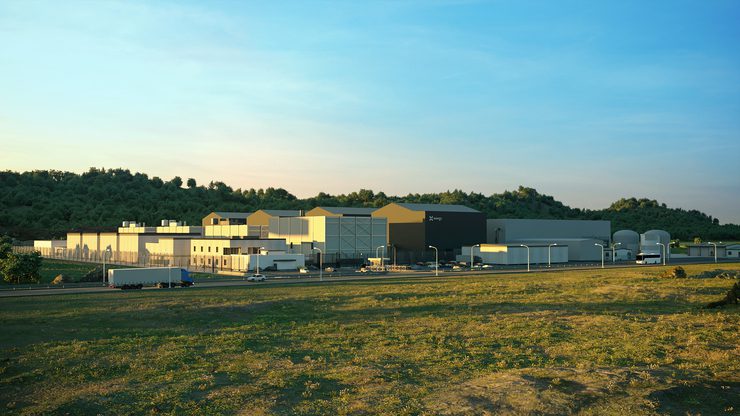SMR Developer X-Energy Completes Canadian Pre-Licensing Milestone, Projects Look Promising
X-Energy Reactor Co. LLC, a developer of advanced small modular nuclear reactors and fuel technology for clean energy generation, reported on Jan. 17 that it has successfully completed milestones in the Canadian Nuclear Safety Commission’s (CNSC’s) pre-licensing Vendor Design Review (VDR). The company submitted the design of its Xe-100 advanced small modular reactor (SMR) to CNSC for a combined Phase 1 and 2 VDR process. Upon completion of these phases, CNSC concluded there are no fundamental barriers to licensing the Xe-100. X-energy said the outcome “increases confidence in proceeding with formal license applications in Canada.”
“The completion of the pre-licensing milestone underscores the regulatory and commercial readiness of the Xe-100 and demonstrates the opportunity to bring our advanced high-temperature gas reactor technology to the Canadian market,” J. Clay Sell, CEO of X-energy, said in a statement announcing the accomplishment. “The work performed through the VDR and our engagements with the CNSC well position X-energy for future licensing applications. This is a great step forward for our high-temperature gas reactor technology and our future industrial and power generation deployments across Canada.”
The Xe-100 Reactor and Fuel
The Xe-100 is a high-temperature gas-cooled reactor that can withstand temperatures exceeding 750C, which X-energy says optimizes energy extraction from each atom. The Xe-100 utilizes fuel pebbles resembling billiard balls in size (Figure 1). These pebbles are embedded with 18,000 tri-structural isotropic (TRISO) fuel particles, in which each particle contains a minute uranium kernel enveloped by three carbon layers. X-energy says this ensures more than “99.99% of unwanted byproducts are contained.” The fuel arrangement eliminates the necessity for extensive containment structures, leading to significantly reduced safety perimeters, as the TRISO fuel itself acts as a containment vessel.

The reactor system employs a seamless process wherein more than 200,000 fuel pebbles are gravity-fed and continuously rotated through the core. The innovative fuel cycle enables uninterrupted operation for up to 60 years, according to X-energy. Helium circulates within the core, absorbing immense quantities of heat without becoming radioactive. This superheated helium is then employed to convert water into steam, subsequently propelling a turbine to generate a constant supply of carbon-free electricity.
Years of Development, Study, and Review
X-energy received an Advanced Reactor Concepts (ARC) award from the U.S. Department of Energy (DOE) back in 2015. The $40 million award helped the company develop its Xe-100 advanced reactor design and TRISO-X particle fuel. The six-year project resulted in X-energy completing the basic design of the Xe-100 reactor under the award and fabricating its first TRISO fuel pebbles using natural uranium at a pilot-scale fuel facility at Oak Ridge National Laboratory, which was commissioned as part of the project.
Since July 2020, X-energy has been engaged with CNSC in its optional VDR process. Activities have included the submission of more than 400 technical documents and white papers across 19 focus areas in the review. The process is said to provide an opportunity for advanced nuclear technology developers like X-energy to demonstrate understanding and compliance with Canadian licensing requirements and seek detailed feedback ahead of a formal license application. Feedback gathered during the process can be incorporated in future CNSC submissions and addressed in future VDR engagements. X-energy said it plans to pro-actively continue working with CNSC in pursuit of Phase 3 VDR in the future.
Promising X-energy SMR Projects
Yet, the first project X-energy aims to complete is not in Canada, but rather, in the U.S. The company and Dow are collaborating to site a four-unit 320-MWe Xe-100 advanced nuclear reactor facility (Figure 2) at Union Carbide Corp. Seadrift Operations, a sprawling Dow chemical materials manufacturing site in Seadrift, Calhoun County, Texas. The project in Seadrift will be the first grid-scale advanced nuclear reactor deployed to serve an industrial site in North America.

X-Energy also has an agreement with Energy Northwest to bring up to 12 Xe-100 units (960 MWe) to Washington state, with the first module expected to be online by 2030. Just last week, Energy Northwest and Puget Sound Energy (PSE) announced an agreement in which PSE will invest $10 million in the nuclear project feasibility phase. This is expected to guide future participation and investment decisions for the Bellevue–based company that touts itself as Washington’s “largest and oldest utility.” PSE supports about 1.2 million electric customers and 900,000 natural gas customers in 10 counties over a 6,000-square-mile area.
Meanwhile, in December at the United Nations Climate Change Conference (COP28) in the United Arab Emirates (UAE), the Emirates Nuclear Energy Corp. (ENEC) signed a memorandum of understanding (MoU) with X-energy to collaborate on the advancement of nuclear energy technologies. ENEC and X-energy will work together to assess technical design and commercial viability of X-energy’s nuclear technologies for the UAE market, to meet the growing demand for clean electricity generation, along with generating steam, heat, and hydrogen to decarbonize industries from manufacturing to petrochemicals as well as other energy-intensive sectors like data centers. The companies will also evaluate potential project partnerships for developments in the UK and Europe, and will develop a regional deployment framework for ENEC-led projects in the Middle East, Africa, and Indian subcontinent.
—Aaron Larson is POWER’s executive editor (@POWERmagazine).